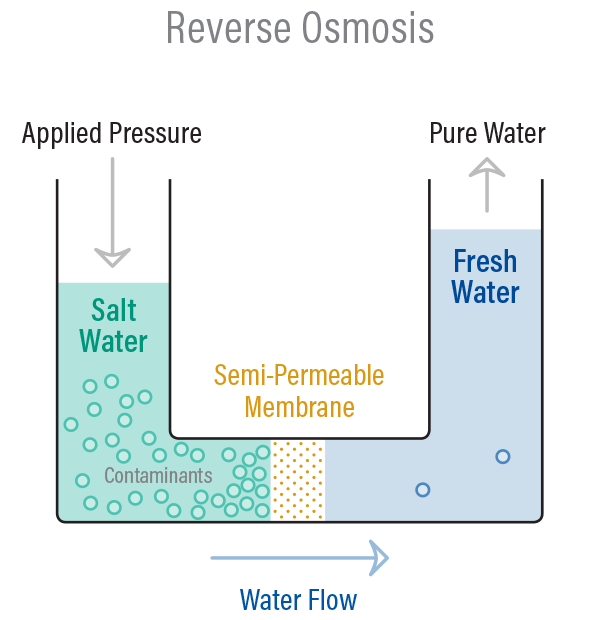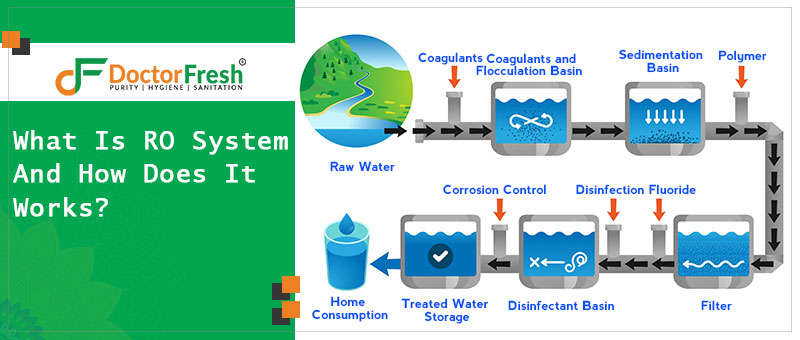You must have heard about the RO water purifier, don't you? In this article, we will be discussing the complete reverse osmosis system, so take a deep breath and let's drive deeply. Let’s start with what is reverse osmosis system?
What Is Reverse Osmosis System?
The reverse osmosis system is a widely used and cost-effective water purification method available in the market. In this system, raw water is forced to pass through a semi-permeable membrane, eliminating contaminants from water. And the purified water store in the storage tank that can be used to drink water.

A semi-permeable membrane used in a reverse osmosis system contains multiple tiny pores that only allows water molecules to pass through it. The size of the pores available in semi-permeable is fine, which not even allow human hair to pass through it.
What Does A Reverse Osmosis System Do?
|
A reverse osmosis system brings pure, fresh and healthy drinking water |
It is fully automatic and eliminates various forms of water contamination |
|
Improve the taste of the water by removing contaminant |
A reverse osmosis system protect you from waterborne diseases |
|
It also eliminates Herbicides & Pesticides |
May also eliminate many other contaminants from water |
How Does A Reverse Osmosis System Work?
A reverse osmosis system works simply, in this filtration process; an external force pushes the tap water to pass through the semi-permeable membrane, resulting in eliminating contaminants from water. In this process, dissolved inorganic substances are eliminated from the water.

A reverse osmosis system also contains pre and post filter. In pre-filter, water enters before it passes through the semi-permeable membrane, whereas in post –filter water enters after it treated by a semi-permeable membrane. Thus, a pre-filter is used to protect reverse osmosis semi-permeable membrane by eliminating dust, dirt and other contamination. In contrast, a post-filter is used to polish the water so that drinking water can be made tasty and better than raw water.
Various Stages Of Reverse Osmosis System?
A reverse osmosis system can be 3,4,5,6 and 7 stages depending upon the filters used in the RO system. Usually, an advanced reverse osmosis system uses below listed filters
- Sediment Filter- This filter is used to eliminate dirt, dust and rust from the water
- Carbon Filter- A carbon filter use to reduce volatile organic compound (VOCs), chlorine, and other contamination from the water
- UF Membrane- This membrane eliminates slightly larger sized particles from the water along with bacteria and other microbes
- Semi-permeable membrane- A semi-permeable membrane used to eliminate up to 98% of total dissolved salts (TDS) from water
- UV Membrane- Kills and suspend the growth of the microbes present in the tap water
- TDS Controller- In this section, minerals are added to the water so that the desirable TDS water can be obtained
Note- A filter can be pre and post depending on whether water passes through those filters before and after semi-permeable membrane
Why Should You Install Reverse Osmosis System?
|
A reverse osmosis system will bring high-quality water for consumption. Here are a few crucial reasons why should you consider installing an RO system at your house |
|
|
#1. Improve Taste Of The Water An RO filtration system eliminates harmful contaminants from the water and improves the taste, odour, and appearance of the water |
#2. Save Money Installation of RO system prevent purchasing costly packed bottle water thus it saves your money |
|
#3. Simple Maintenance A reverse osmosis system has less moving and replacement parts that make the RO system easy to clean and service |
#4. Eliminate Complete Impurities A reverse osmosis system can eliminate complete water contaminants from water, including nitrates, VOCs, chlorine, and others |
|
A reverse osmosis system prevents various kinds of waterborne diseases like Cholera, Diarrhoea, Typhoid, and others. |
|
Note- An RO system is one of the best water filtration systems if you are looking for improved taste, odour, and water quality.
Impurities Do A Reverse Osmosis System Eliminate
- Fluoride
- Salts
- Sediment
- Chlorine
- Arsenic
- VOCs
- Herbicides
- Pesticides
What Does Reverse Osmosis System Remove?
|
A reverse osmosis system eliminates various kinds of contamination like arsenic, fluoride, and others through pre-filter, post-filter, and RO membrane. |
|
|
Salts |
Leads |
|
pesticides |
VOCs |
|
Chlorine & Chloramine |
Sediments |
|
Arsenic |
Herbicides & Pesticides |
|
The above-listed water contaminants are some of the most widespread pollutants eliminated by reverse osmosis system, but an RO system may also eliminate various other contamination present in water. |
|
How Much Contamination Can A Reverse Osmosis System Eliminate- Percentage Wise
|
Contaminant |
% Removal |
|
Pesticides |
Up to 99 |
|
Chlorine |
Up to 98 |
|
Sulfate |
96-98 |
|
Phosphate |
96-98 |
|
Nickel |
96-98 |
|
Lead |
95-98 |
|
Mercury |
95-98 |
|
Barium |
95-98 |
|
Calcium |
94-98 |
|
Arsenic |
92-96 |
|
Sodium |
85-96 |
|
Fluoride |
85-92 |
|
Nitrates |
60-75 |
Advantage Of Having RO System
A reverse osmosis system is an advanced and modern technology-based water purification machine that can remove up to 98% of TDS present in the water and make water safe for drinking purposes. Although there are various other methods to eliminate contamination from the water, not all is as efficient as an RO system. Below are some of the other but most crucial benefits of having a reverse osmosis system, and these are
- Reduce harmful dissolved contaminants from water
- Eliminate contaminants from water which causes unpleasant odour thus improve the taste of the water
- It is environmental friendly compare to the bottled water
- A reverse osmosis system is simple and easy to install
- Available in various sizes. It can also fit under the kitchen sink
Note- An Reverse Osmosis System possesses multiple other benefits than the above-listed one.
Reverse Osmosis System Uses In Various Industries
|
With the increasing water pollution level, demand for reverse osmosis systems has also increased tremendously in various sectors. Below we have listed RO system uses in multiple industries |
|
|
Food & Beverage industry |
Pharmaceutical companies |
|
Agriculture Industry |
Power & Energy Industries |
|
Boiler Feed |
Hospital |
|
Hotel |
Disaster Relief |
|
Mining |
Marine |
|
Besides this, reverse osmosis has shown its importance in various sectors like school, college, path & research labs, etc. |
|
Some Essential Tips For Maintaining Reverse Osmosis System
Reverse osmosis filters get muddy due to the regular treatment of contaminated water; thus, it is crucial to maintain your RO system else it may lose its ability to purify water. Below, we have shared some of the essential tips that will help you retain the RO water purification system for a longer duration. These steps are
- Regular Cleaning- Expert suggest that reverse osmosis filters must get proper cleaning and sanitation so that the filter's efficiency and productivity can be maintained for a longer duration because due to regular encountering with the water contaminants, the filters of the RO system get muddy as a result its efficiency decreases
- Replacement Of Filters- An RO system filter needs to be replaced within 6 to 24 months depending upon the types of filters used in the RO system and concentration of contamination present in the water
- Annual Maintenance Program- This is a yearly contract in which your RO system gets treated frequently throughout the whole year to maintain productivity and efficiency for the longer duration.

